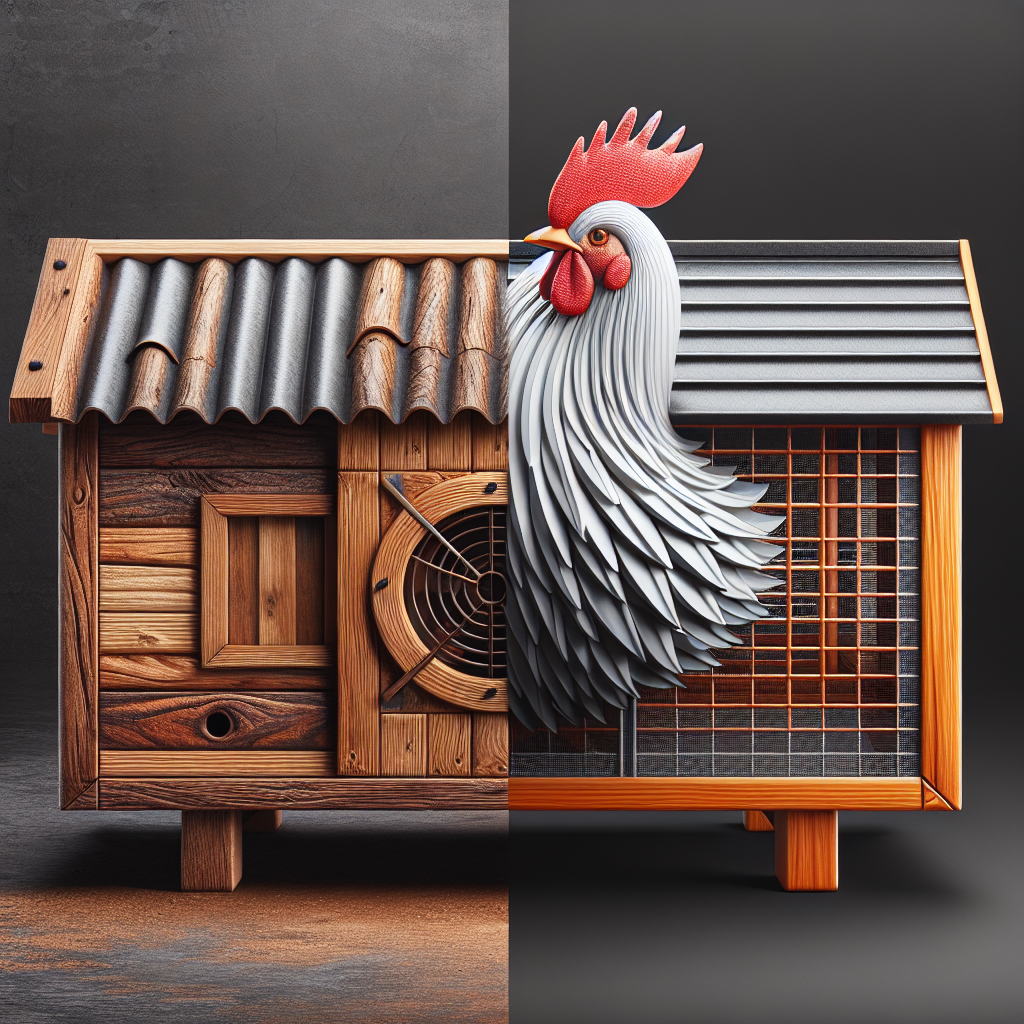Living in an urban setting can be exciting, with its vibrant energy and constant activity. However, one challenge that urban dwellers often face is dealing with the noise that comes with it. For those who have coops or chicken enclosures in their urban homes, ensuring sound insulation is crucial to maintaining peace and tranquility. But what materials are best suited for this purpose? In this article, we will explore the various options available to effectively block out the noise and create a comfortable and quiet environment for your feathered friends.
Categorizing Sound Insulation Materials
When it comes to ensuring sound insulation in coops located in urban settings, there are various materials that can be used. These materials can be broadly categorized into two main types: sound absorption materials and soundproofing materials.
Sound Absorption Materials
Sound absorption materials are designed to absorb sound waves and prevent sound from bouncing off surfaces, thus reducing echo and noise levels. These materials are commonly used in spaces where reducing reverberation and echo is desired, such as recording studios or theaters.
Soundproofing Materials
Soundproofing materials, on the other hand, are specifically designed to block or isolate sound from entering or leaving a space. They effectively reduce the amount of noise transmission, making them ideal for applications where noise control is essential, such as in coops located in urban settings.
Factors Affecting Material Selection
Before choosing the right sound insulation material for your coop, it is important to consider several factors that may influence your selection. These factors include:
Noise Type
Identifying the type of noise you want to minimize or block is crucial in determining the best material to use. Different materials have varying degrees of effectiveness in reducing different types of noise, including airborne noise, impact noise, or a combination of both.
Location of the Coop
The location of your coop within an urban setting can also impact your material selection. If your coop is located near busy streets or commercial areas, you may need to consider materials with better soundproofing capabilities to block out external noise. However, if the main concern is reducing noise from within the coop, sound absorption materials can be more suitable.
Budget
The budget available for your sound insulation project is another important factor. Some materials, such as high-end acoustic panels, can be more expensive than others. It is essential to find a balance between the desired level of sound insulation and the available budget.
Ease of Installation
Consider the complexity of installing the sound insulation materials. Some materials may require professional installation, while others can be easily installed by homeowners. It is important to choose materials that are compatible with your level of DIY expertise or budget for professional installation if needed.
Aesthetics
The visual appearance of the sound insulation materials may also be a consideration. Some materials, like acoustic panels, can be customized to blend seamlessly with the existing decor of your coop. This allows you to achieve both sound insulation and a visually pleasing environment.
Sound Absorption Materials
Sound absorption materials are an excellent choice if your main concern is reducing echo and reverberation within your coop. Here are a few commonly used sound absorption materials:
Fiberglass Insulation
Fiberglass insulation is a popular choice for sound absorption due to its affordability and effectiveness. It is made of tiny glass fibers, which trap sound waves and prevent them from bouncing around the space. Fiberglass insulation can be easily installed in walls, ceilings, and floors.
Overview
Fiberglass insulation is a lightweight and versatile material commonly used for thermal insulation purposes. However, it also offers excellent sound absorption properties, making it a popular choice for reducing noise levels in coops.
Features
Fiberglass insulation is typically available in the form of batts or rolls, making it easy to cut and fit into various spaces. It is made of inorganic fibers that are resistant to mold, mildew, and insects. Additionally, fiberglass insulation has a high NRC (Noise Reduction Coefficient), indicating its excellent sound absorption capabilities.
Installation
Installing fiberglass insulation is a relatively straightforward process. It can be easily cut to size using a utility knife and then placed between wall studs, ceiling joists, or floor joists. It is important to wear protective gear, such as gloves and a mask, during installation to avoid skin irritation and inhalation of fiberglass particles.
Effectiveness
Fiberglass insulation is effective in reducing airborne noise and improving sound quality within a space. It helps absorb sound waves, reducing echo and reverberation. However, it may not be as effective at blocking low-frequency or impact noise.
Considerations
When using fiberglass insulation for sound absorption, it is important to ensure proper installation to achieve maximum effectiveness. Additionally, fiberglass insulation may not be suitable for areas with moisture concerns, as it can absorb and hold moisture, leading to potential mold or mildew issues.
Mineral Wool
Mineral wool, also known as rock wool or stone wool, is another commonly used material for sound absorption. It is made from natural or synthetic minerals and provides excellent acoustic properties.
Overview
Mineral wool is made by melting natural or synthetic minerals, such as basalt or slag, and spinning them into fibers. The resulting insulation material has a high density and is effective at reducing sound transmission.
Features
Mineral wool insulation is available in different forms, including batts, boards, and loose-fill. It has excellent fire resistance properties and is also resistant to rot, mold, and pests. Mineral wool insulation has a high NRC, indicating its ability to absorb sound and reduce noise levels effectively.
Installation
Mineral wool insulation can be installed in a similar manner to fiberglass insulation. It is important to wear protective gear, such as gloves and a mask, during installation. Mineral wool batts or boards can be placed between wall studs, ceiling joists, or floor joists to effectively reduce sound transmission.
Effectiveness
Mineral wool insulation provides effective sound absorption, reducing echo and reverberation within a space. It is particularly effective at blocking high-frequency noise, making it a suitable choice for reducing airborne noise.
Considerations
Similar to fiberglass insulation, proper installation is key to achieving maximum sound absorption with mineral wool. Additionally, mineral wool is a denser material compared to fiberglass, which may result in more challenging installation.
Acoustic Panels
Acoustic panels are designed specifically for sound absorption and are widely used in professional recording studios, theaters, and other spaces where optimal acoustics are desired.
Overview
Acoustic panels are rigid boards or panels made from various sound-absorbing materials, such as foam, fabric-wrapped fibers, or perforated wood. They are designed to absorb sound waves and prevent them from bouncing back into the room.
Features
Acoustic panels come in a variety of sizes, shapes, and designs. They can be fully customizable to suit various aesthetic preferences and can even be printed with custom artwork or images. Acoustic panels are highly durable, fire-resistant, and have excellent sound absorption properties.
Installation
Installing acoustic panels typically involves attaching them directly to the walls or ceilings using adhesive or mounting hardware. They can be installed in a pattern or arrangement that best suits the acoustic requirements of the space.
Effectiveness
Acoustic panels are highly effective at reducing echo and reverberation within a space, making them perfect for sound absorption. They can significantly improve the overall sound quality and clarity of a room.
Considerations
When selecting acoustic panels, consider the specific acoustic requirements of your coop. Different materials and designs have varying degrees of sound absorption capabilities. It is also important to ensure proper installation to achieve maximum effectiveness.
Corkboard
Corkboard is a natural and environmentally friendly material that provides good sound absorption properties and is visually appealing.
Overview
Corkboard is made from the bark of the cork oak tree. It is a lightweight and porous material with excellent sound absorption characteristics.
Features
Corkboard has a unique cellular structure that allows it to absorb sound waves and reduce echo and reverberation. It is also a sustainable and renewable material, making it an eco-friendly choice. Corkboard comes in various sizes and thicknesses, allowing for flexibility in installation.
Installation
Corkboard can be installed on walls, ceilings, or floors using adhesive or nails. It is important to ensure proper adhesion to the surface to achieve maximum sound absorption.
Effectiveness
Corkboard is effective at reducing airborne noise and improving sound quality within a space. It helps absorb sound waves, reducing echo and reverberation.
Considerations
While corkboard is a versatile material, it may not be as effective at blocking impact noise or low-frequency noise compared to other soundproofing materials. Consider using corkboard in combination with other soundproofing materials for optimal results.
Soundproofing Materials
If your main concern is blocking external noise from entering your coop or preventing noise from escaping, soundproofing materials are the way to go. Here are a few commonly used soundproofing materials:
Mass Loaded Vinyl (MLV)
Mass Loaded Vinyl (MLV) is a dense and flexible material that is commonly used for soundproofing applications. It is particularly effective at blocking airborne noise.
Overview
Mass Loaded Vinyl is made from a combination of mineral fillers, such as barium sulfate or calcium silicate, and PVC or vinyl. It is a dense and heavy material that offers excellent soundproofing properties.
Features
MLV is highly flexible and can be easily cut and shaped to fit various spaces. It is also resistant to moisture, mold, and mildew. MLV has a high STC (Sound Transmission Class) rating, indicating its effectiveness in blocking airborne noise.
Installation
MLV can be installed by simply hanging or attaching it to walls, ceilings, or floors using adhesive or nails. It can also be sandwiched between layers of drywall or other building materials for added soundproofing.
Effectiveness
MLV effectively blocks airborne noise, including voices, traffic noise, or other external sounds. It also helps reduce noise transmission between rooms, making it an excellent choice for soundproofing coops.
Considerations
While MLV is highly effective at blocking airborne noise, it may not be as effective at blocking impact or low-frequency noise. Consider using additional soundproofing materials, such as soundproof drywall or acoustic caulk, to achieve optimal results.
Double-Pane Windows
Double-pane windows, also known as insulated glass windows, are designed to provide better thermal insulation and noise reduction compared to single-pane windows.
Overview
Double-pane windows consist of two glass panes separated by a layer of air or gas, such as argon. The additional layer creates a barrier that reduces noise transmission and improves thermal insulation.
Features
Double-pane windows are available in various styles and frame materials, allowing for customization to fit the aesthetics of your coop. They provide better insulation compared to single-pane windows, helping to reduce both noise and heat loss.
Installation
Replacing existing windows with double-pane windows typically requires professional installation. The installation process involves removing the existing windows and carefully fitting and sealing the double-pane windows in their place.
Effectiveness
Double-pane windows significantly reduce the amount of noise entering your coop from outside. They also help to create a more comfortable and energy-efficient living environment by reducing heat loss or gain.
Considerations
While double-pane windows provide effective noise reduction, they may not be as effective as other soundproofing materials, especially for low-frequency noise or noise that originates from within the coop. Consider using additional soundproofing materials in combination with double-pane windows for optimal noise reduction.
In conclusion, when it comes to sound insulation in coops located in urban settings, a combination of sound absorption materials and soundproofing materials may be necessary to achieve the desired level of noise reduction. Consider factors such as the type of noise, location of the coop, budget, ease of installation, and aesthetics when selecting the appropriate materials. By carefully considering these factors and choosing the right materials for your specific needs, you can create a quieter and more comfortable living environment for you and your chickens.




